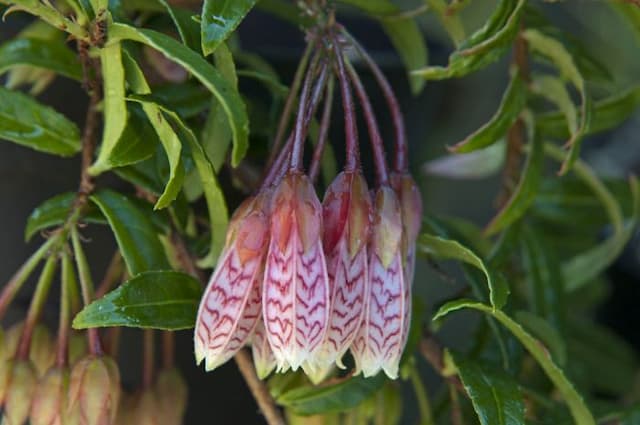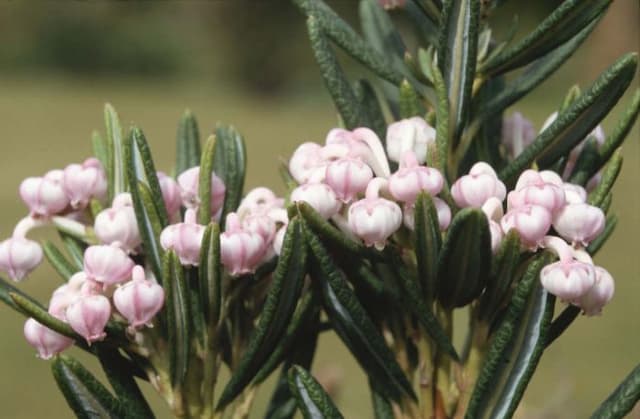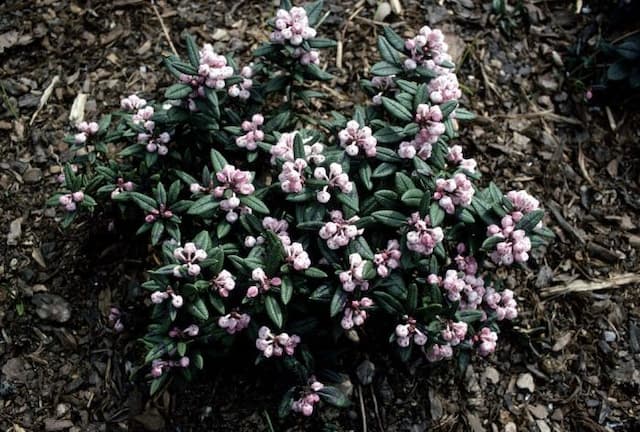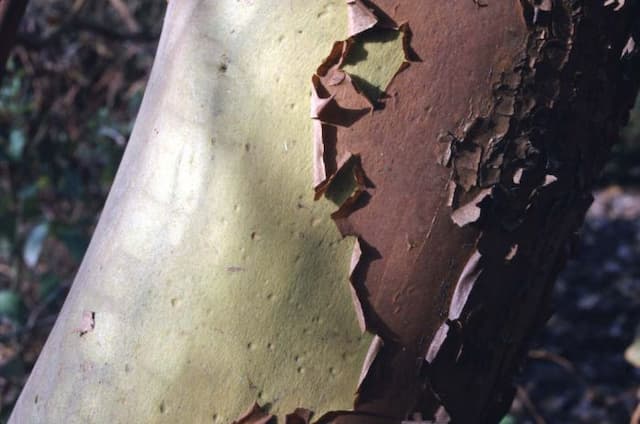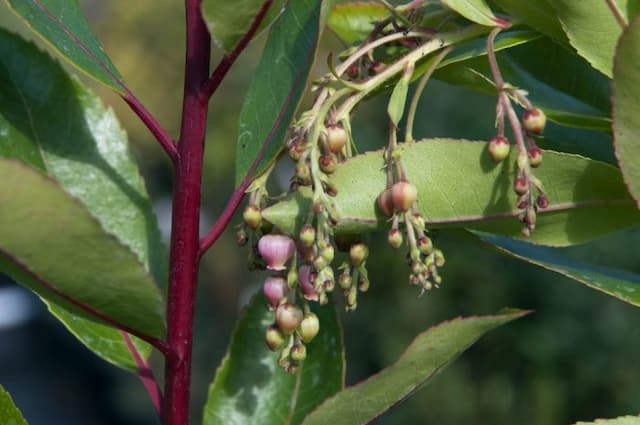Christmas Cheer Rhododendron Rhododendron 'Christmas Cheer' (caucasicum hybrid)

ABOUT
The Rhododendron 'Christmas Cheer' is a captivating ornamental shrub that is especially noted for its splendid floral display. This plant is characterized by its vibrant, evergreen foliage that provides a lush backdrop to its main attraction – the charming flowers. These blossoms exhibit a delightful pink hue often softening to a paler pink or nearly white color with subtle variations across the petals. Each flower cluster presents itself in a compact, rounded truss, making each floral display seem like a meticulously arranged bouquet. The foliage consists of glossy, dark green leaves that maintain their luster throughout the year. These leaves are oblong with a smooth texture and possess a leathery quality that complements the delicate nature of the flowers. The juxtaposition of the robust foliage against the tender blossoms adds to the visual interest of the shrub. Coming into bloom during the cooler season, the Rhododendron 'Christmas Cheer' earned its name for the gift of color it provides when the landscape is often more subdued. The blooms provide a refreshing dash of color that can brighten up any garden setting during a time when few other plants are in flower. The Rhododendron 'Christmas Cheer' holds an upright and dense form, contributing to a structural presence in a garden design. Its general appearance is neat and well-proportioned, making it a suitable choice for a focal point in the garden or as part of a mixed border. The plant's ability to produce such a heralded pop of color during the colder months, along with its year-round foliage, makes it a valuable and eye-catching addition to any temperate landscape.
About this plant
 Names
NamesFamily
Ericaceae
Synonyms
Christmas Cheer Rhododendron, Caucasicum Rhododendron
Common names
Rhododendron 'Christmas Cheer'
 Toxicity
ToxicityTo humans
Rhododendron, including the 'Christmas Cheer' variety, contains toxic substances, primarily grayanotoxins, that can be harmful if ingested. Symptoms of poisoning include nausea, vomiting, drooling, diarrhea, lethargy, weakness, abdominal pain, and hypotension. Severe cases can result in coma or death due to cardiovascular collapse.
To pets
Rhododendron is toxic to pets, such as cats and dogs, as it contains grayanotoxins. Ingesting even a few leaves can cause symptoms like vomiting, diarrhea, hypersalivation, weakness, and central nervous system depression. Arrhythmias, cardiovascular collapse, and potentially death can occur in severe cases of poisoning.
 Characteristics
CharacteristicsLife cycle
Perennials
Foliage type
Evergreen
Color of leaves
Green
Flower color
Pink
Height
4-5 feet (1.2-1.5 meters)
Spread
4-6 feet (1.2-1.8 meters)
Plant type
Shrub
Hardiness zones
5
Native area
Caucasus
Benefits
 General Benefits
General Benefits- Aesthetic Appeal: 'Christmas Cheer' rhododendron flaunts beautiful pink to pale lavender flowers that herald the spring season, adding color and vibrancy to gardens.
- Compact Growth: Its relatively small size and compact growth habit make it ideal for smaller gardens or spaces, and it can also be used in container gardening.
- Durable Landscape Plant: This plant is known for its hardiness and can withstand cold temperatures, making it a durable choice for many climates.
- Evergreen Foliage: With its evergreen leaves, 'Christmas Cheer' rhododendron provides year-round color and structure to the landscape.
- Low Maintenance: Once established, rhododendrons require minimal care, making them ideal for gardeners who prefer low-maintenance plants.
- Attracts Pollinators: The flowers are attractive to pollinators such as bees and butterflies, which are essential for the health of the garden and the environment.
 Medical Properties
Medical PropertiesThis plant is not used for medical purposes.
 Air-purifying Qualities
Air-purifying QualitiesThis plant is not specifically known for air purifying qualities.
 Other Uses
Other Uses- Rhododendron 'Christmas Cheer' petals can be used for natural dyeing, providing a range of colors depending on the mordant used.
- The leaves of Rhododendron 'Christmas Cheer' can be used in floral arrangements as a long-lasting green backdrop for other flowers.
- The wood of Rhododendron 'Christmas Cheer' is sometimes utilized in small scale woodworking or craft projects due to its density.
- This plant can serve as a natural insect repellent because some Rhododendron species contain compounds that insects find unpalatable.
- Rhododendron 'Christmas Cheer' can be used as a teaching tool in botanical studies due to its distinctive features and hybrid status.
- Dried Rhododendron 'Christmas Cheer' leaves can be incorporated into potpourri mixes for their texture and ability to retain scents.
- Rhododendron 'Christmas Cheer' sap can be used cautiously in small quantities as a natural adhesive in certain traditional crafts.
- The blooms of Rhododendron 'Christmas Cheer' may be pressed and used in herbarium collections or for decorative art purposes.
- Used in landscaping to create a formal appearance, the Rhododendron 'Christmas Cheer' can be pruned into geometric shapes and hedges.
- With careful handling, the bark of Rhododendron 'Christmas Cheer' can be included in terrariums or as a mulch for acid-loving plants.
Interesting Facts
 Feng Shui
Feng ShuiRhododendrons are not typically associated with Feng Shui practice.
 Zodiac Sign Compitability
Zodiac Sign CompitabilityRhododendrons are not used in astrology practice.
 Plant Symbolism
Plant Symbolism- Beware: The Rhododendron plant is often associated with caution due to its toxic properties. Ingesting its leaves or nectar can be harmful.
- Elegance and Wealth: The Rhododendron's large, vibrant blooms and association with stately gardens have made it a symbol of elegance and affluence.
- Warning: Similar to "beware," Rhododendron can symbolize a warning to pay attention to approaching danger or to proceed with caution in a situation.
- Survival: Rhododendrons are known for their hardiness and ability to thrive in challenging climates, representing resilience and an ability to overcome adversity.
- Homecoming and Hospitality: In some cultures, the Rhododendron is symbolic of homecoming and hospitality, as it is an inviting plant often found near homes and in gardens.
 Water
WaterThe Rhododendron 'Christmas Cheer' should be watered deeply and thoroughly, ensuring that the soil is evenly moist but not soggy, as root rot can occur in waterlogged conditions. Typically, an inch of water per week is sufficient but may need to be increased during dry spells or hot weather. It's best to water this plant early in the morning or late in the afternoon to reduce evaporation. During the winter, water only when the ground is not frozen and the plant is clearly in need. Always allow the top few inches of soil to dry out between waterings to encourage strong root growth.
 Light
LightRhododendron 'Christmas Cheer' thrives best in dappled shade or partial sun. The ideal spot provides protection from harsh afternoon sun that can scorch the leaves, while still offering enough light to support healthy growth. Morning sun with afternoon shade or filtered light throughout the day is perfect for these plants.
 Temperature
TemperatureRhododendron 'Christmas Cheer' prefers moderate temperatures and can generally handle minimum winter temperatures down to about 20°F. The ideal temperature range for their growth is between 50°F and 75°F. Exposing the plant to temperatures above 80°F or below 20°F for extended periods can cause stress or damage.
 Pruning
PruningPruning Rhododendron 'Christmas Cheer' is mainly done to remove dead, damaged, or diseased branches, which promotes the overall health and appearance of the plant. The best time for pruning is soon after the flowers have finished blooming to avoid cutting off next year's buds. Light pruning each year helps maintain the plant's shape and encourages more prolific blooming.
 Cleaning
CleaningAs needed
 Soil
SoilRhododendrons require a well-draining, acidic soil mix with a pH of 4.5 to 6.0. A good recipe includes equal parts of peat moss, pine bark, and perlite to ensure proper drainage and aeration. Fertilize lightly as Rhododendrons can be sensitive to over-fertilization.
 Repotting
RepottingThe Rhododendron, commonly known as 'Christmas Cheer', should be repotted every 2 to 3 years or when the roots have outgrown the pot. Use a larger pot to allow for growth and refresh the acidic soil mix to provide the plant with new nutrients.
 Humidity & Misting
Humidity & Misting'Christmas Cheer' Rhododendron thrives best with moderate humidity levels. Aim for a humidity level of around 50-60% as too dry air can damage the leaves, while excessive moisture may promote fungal diseases.
 Suitable locations
Suitable locationsIndoor
Place in bright, indirect light and ensure high humidity.
Outdoor
Part shade to full sun with moist, well-draining acidic soil.
Hardiness zone
5-8 USDA
 Life cycle
Life cycleRhododendron 'Christmas Cheer' starts its life cycle as a seed, which after germination grows into a young seedling. The seedling goes through a juvenile phase where it develops a root system and foliage but does not yet flower. As it matures into an adult plant, it begins the vegetative growth phase, producing leaves and woody stems. This species is a long-lived perennial that can enter the reproductive phase each spring, producing characteristic pink to light red flowers that attract pollinators. After pollination, the flowers develop into seed capsules containing numerous minute seeds. The plant enters a period of dormancy during colder months before resuming its growth cycle with new vegetative growth in the spring.
 Propogation
PropogationPropogation time
Early Spring
The most popular method of propagation for the Rhododendron 'Christmas Cheer' is through semi-hardwood cuttings. This typically occurs during the late summer months, after the new growth has started to mature and harden slightly. Cuttings should be about 4 to 6 inches long and contain several sets of leaves. The lower sets of leaves are removed, and the cut end is dipped in rooting hormone before being placed in a well-draining growing medium. The cutting should then be kept in high humidity and indirect light until roots develop, which usually takes several weeks. After rooting, the new plant can be transferred to a larger pot or to its permanent location in the garden.
